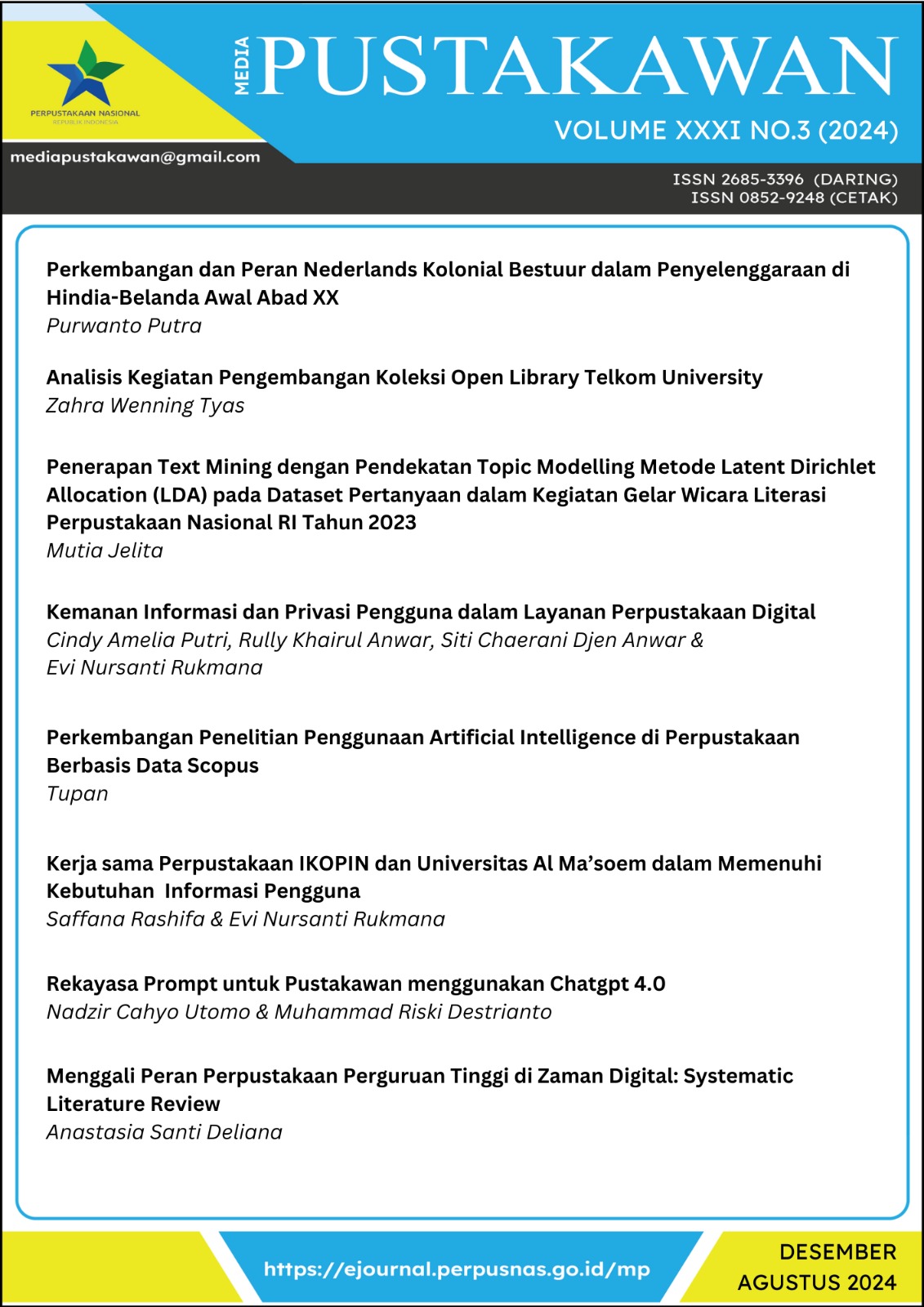Kerja Sama Perpustakaan IKOPIN dan Perpustakaan Universitas Al-Mas'oem dalam Memenuhi Kebutuhan Informasi Pengguna
DOI:
https://doi.org/10.37014/medpus.v31i3.4924Keywords:
perpustakaan perguruan tinggi, kebutuhan informasi, kerja sama, struktur organisasi, tri dharma perguruan tinggi, college library, information needs, cooperation, organizational structure, tri dharma of higher educationAbstract
IKOPIN and Al-Mas'oem University Libraries are university libraries that play an important role in supporting implementation of Tri-Dharma of higher education. In order to fulfill this function, it is impossible for university libraries to act independently. Cooperation is needed in fulfillment, improvement, development, procurement and promotion of the services provided by the library to its users. This research aims to see how cooperation and impact of organizational structure in the cooperation carried out by IKOPIN Library and Al-Mas'oem University in meeting the information needs of users. This research has been conducted using a qualitative approach through a case study research instrument through observation, interviews, and literature studies. The process is carried out with the existence of MoA, MoU and discussions related to the collaboration. The impact of the cooperation between IKOPIN Library and Al-Mas'oem University can be seen in the improvement of quality and services that mainly affect users and librarians through cross borrowing services, librarian comparative studies, information exchange and joint collection procurement. In practice, the cooperation between the two libraries has not been successful. The unsuccessful cooperation between the two libraries is caused by many things, but the most likely is the inappropriate organizational structure implemented.References
Annisya, Zuhri, R. A., Restiana, & Yusniah. (2023). Kerjasama jaringan perpustakaan di Indonesia: Studi kasus jaringan Perpustakaan Nasional Republik Indonesia. Dawatuna: Journal of Communication and Islamic Broadcasting, 3(1), 453-468. http://dx.doi.org/10.47467/dawatuna.v3i1.2510
Antivachis, N. A., & Angelis, V. A. (2015). Network organizations: The Question of governance. Procedia - Social and Behavioral Sciences, 175, 584-592. https://doi.org/10.1016/j.sbspro.2015.01.1241
Atkinson, J. (2019). Collaboration by academic libraries: What are the benefits, what are the constraints, and what do you need to do to be successful? New Review Of Academic Librarianship, 25(1), 1-7. https://doi.org/10.1080/13614533.2019.1575016
Cahyono, T. Y. (2011). Kerjasama dan standarisasi perpustakaan dalam mendukung kecepatan akses informasi. Universitas Negeri Malang. http://repository.um.ac.id/id/eprint/1472
Darwanto, Utami, A. K., & Gusniawati, N. (2015). Pedoman penyelenggaraan perpustakaan perguruan tinggi. Perpustakaan Nasional RI.
Daulay, A. F. (2016). Dasar-dasar managemen organisasi. Al-Irsyad: Jurnal Pendidikan dan Konseling, 6(2), 34-48. http://dx.doi.org/10.30829/al-irsyad.v6i2.6614
Edgar, W. (2004). Corporate library impact, part i: A Theoritical approach. The Library Quarterly: Information, Community, Policy, 74(2), 122-151.
Goulding, A., & Walton, G. (2013). Leading collaboration in public and academic libraries. LIANZA Conference 2013, Hamilton, New Zealand. https://www.researchgate.net/publication/276279255_Leading_Collaboration_in_Public_and_Academic_Libraries
Hariawan, F. (2017). Organization structure development based oncompany business process. Asian Journal of Innovation and Entrepreneurship, 2(3), 247-253. https://journal.uii.ac.id/ajie/article/view/8287/7501
Henderson, M. (2016). Successful partnerships for academic libraries. Journal of New Librarianship, 1(1), 28-54. https://newlibs.org/index.php/jonl/article/view/567
Hidayat, T. (2019). Pembahasan studi kasus sebagai bagian metodologi penelitian. Jurnal Studi Kasus, 1-13.
Kumar, A. (2022). Observation method. Library Philosophy and Practices, 13(6), 1-14. https://www.researchgate.net/publication/360808469_OBSERVATION_METHOD
Lazarevic, M., & Mosurovic, M. (2023). Organizational Structure and Organizational Culture. Economic Analysis: Applied Research in Emerging Markets, 56(2), 39-53. doi:10.28934/ea.23.56.2.pp39-53
Lubis, T. A. (2023, April 13). Teknik analisis data: Pengertian, jenis dan cara memilihnya. https://uptjurnal.umsu.ac.id/teknik-analisis-data-pengertian-jenis-dan-cara-memilihnya/
Miles, M. B., & Huberman, A. M. (1994). An Expanded sourcebook qualitative data analysis (2nd ed.). Sage Publication Inc. https://vivauniversity.files.wordpress.com/2013/11/milesandhuberman1994.pdf
Muhammad, O. (2015). Advantages and disadvantages of line and staff style of organizations. International Review (3-4), 33-38. http://dx.doi.org/10.5937/intrev1504033O
ODonnell, P., & Anderson, L. (2022). The University Library: Places for Possibility. New Review Of Academic Librarianship, 28(3), 232-255. https://doi.org/10.1080/13614533.2021.1906718
Papassavas, A., Chatzistamatiou, T., Michalopoulos, E., Serafetinidi, M., Gkioka, V., Markogianni , E., & Stavropoulos-Giokas, C. (2015). Quality management systems including accreditation standards. Cord Blood Stem Cells and Regenerative Medicine, 229-248. https://doi.org/10.1016/B978-0-12-407785-0.00017-7
Prasetya, A. P. (2021). Kerjasama perpustakaan. https://idr.uin-antasari.ac.id/17538/1/MAKALAH%20KERJASAMA%20PERPUSTAKAAN.pdf
Quinn, K. (2022). The University library as bellwether: Examining the public role of higher education through listening to the library. Civic Sociology, 3(1). https://doi.org/10.1525/cs.2022.32635
Rahayu, S. (2017). Mengenal perpustakaan perguruan tinggi lebih dekat. Buletin Perpustakaan Universitas Islam Indonesia (57), 103-110. https://journal.uii.ac.id/Buletin-Perpustakaan/article/view/9109
Setiyawati, N., Wharman, W. S., Syadiah, L., & Wiyani, S. (2023). Struktur organisasi dan implementasinya padaorganisasi koperasi mahasiswa. https://doi.org/10.31219/osf.io/b6ahf
Shang, S., Mi, Y., Yang, L., Jiao, K., Sheng, F., Shen, Y., & Guo, H. (2017). An Overview of the development of university library in the information age. Open Journal of Social Science, 1-10. https://doi.org/10.4236/jss.2017.511001
Sumitro. (2014). Keuntungan dan kelemahan dari setiap jenis struktur organisasi. Informatika : Jurnal Ilmiah AMIK Labuhan Batu, 2(2), 35-51. https://feb.ulb.ac.id/wp-content/uploads/2021/08/01-Keuntungan-dan-Kelemahan.pdf
Syarif, V. D. (2020). Peningkatan kerjasama perpustakaan perguruan tinggi dalam pelayanan informasi. Ecodunamika, 3(2), 1-4. https://ejournal.uksw.edu/ecodunamika/article/view/3285
Utibe, T. (2019). Impacts of interview as research instrument of data collection in social sciences. Journal of Digital Art & Humanities, 1(1), 15-24. https://doi.org/10.33847/2712-8148.1.1_2
Winoto, Y. (2017). Model jaringan kerjasama antar perpustakaan perguruan tinggi islam di wilayah Provinsi Jawa Barat. Commed : Jurnal Komunikasi dan Media, 2(1), 77-93. doi:https://doi.org/10.33884/commed.v2i1.238
Yin, R. K. (1996). Studi kasus: Desain dan metode. PT. RadjaGrafindo Persada.
Yusniah, Al Anshori, M. F., Sari, J. E., & Syahrina, J. (2022). Bidang kerjasama jaringan perpustakaan. Jurnal Pendidikan dan Konseling, 4(6), 1450-1455.
Yusniah, Fauzi, A., Ramadhan, R., Sitorus, R., & Mulyadi, R. (2023). Strategi pengembangan kerjasama Perpustakaan UINSU dengan Perpustakaan UMSU dalam upaya meningkatkan layanan perpustakaan. El Mujtama: Jurnal Pengabdian Masyarakat, 3(2), 452-459. https://doi.org/10.47467/elmujtama.v3i2.2706
Downloads
Published
How to Cite
Issue
Section
License

This work is licensed under a Creative Commons Attribution-NonCommercial-ShareAlike 4.0 International License.








